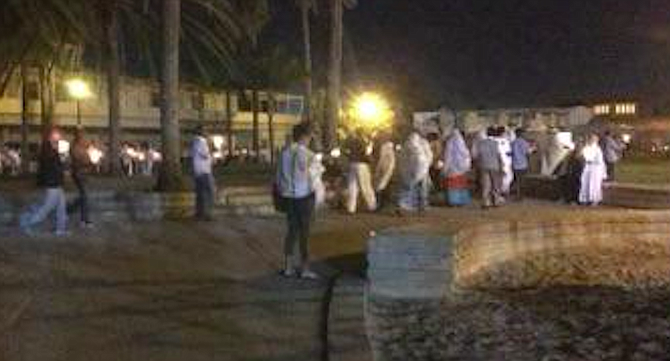 Facebook
Facebook
 X
X
 Instagram
Instagram
 TikTok
TikTok
 Youtube
Youtube

The procession started slowly Tuesday night as people walked a block along the fence on School Street that defines the John Adams Elementary School park boundaries — we didn't pay heed at first, thinking it was a party at the Normal Heights Community Center on the corner wrapping up.
In the park, we were enjoying the cool night and chatting, doing park stuff like other clusters of people in the hour after sunset. Neighborhood kids rode around on bikes, while older youths clustered around a bench.
But the steady stream of people — hundreds and hundreds of people — continued unabated; a curious sight on a normally empty street. After minutes of watching what seemed like an endless flow of people, I started to grasp how many were in that steady stream. It was a river of people sprung from the corner a block west, that flowed past us to the gate at School St. and Mansfield, then, slowly came into the park through the gate.
They were all ages, grandmothers and toddlers, some dressed in traditional African clothes and scarves draped around the faces of many women, others in American casual, and a whole range in between.
The somber, polite stream of hundreds of people reached the gate, where they were given lighted candles, then continuing their purposeful pace into the long loop in the park, now walking four and five abreast, carrying candles. At first they walked in silence, but soon they began to sing a sad and determined anthem in a language I don't understand. There were so many people that the tenth of a mile loop was full of people in what must have been a ceremony of some kind.
It was. We stepped out of the way, stood back respectfully and watched, trying to decipher what was happening.
"This is the Eritrean Day of the Martyrs," a man told me. "We do this every June 20th, we come here and walk around the circle three times."
For 30 years, until 1991, Eritreans fought for independence — for freedom.
"Many, many died," a woman at the gate told. "Too many. 25,000, more."
Then as they came, they left. Many people hugging and kissing, friends promising to get together soon. Moms letting children play on the playground equipment of big, bright toys.
According to state statistics, most of San Diego's Eritrean community arrived either because of that 30-year war, or between 2002 and 2010 — after the ugly and repressive turn taken by the nation's ruler, once the leader of the celebrated freedom fighters.
Human Rights Watch called the country "one of the world's most oppressive governments." Others describe it as "the fastest emptying country in the world", since half of its residents had chosen years of misery and danger to escape torture, midnight police visits and subsequent disappearances, imprisonment for not showing enough enthusiasm, and worse.


The procession started slowly Tuesday night as people walked a block along the fence on School Street that defines the John Adams Elementary School park boundaries — we didn't pay heed at first, thinking it was a party at the Normal Heights Community Center on the corner wrapping up.
In the park, we were enjoying the cool night and chatting, doing park stuff like other clusters of people in the hour after sunset. Neighborhood kids rode around on bikes, while older youths clustered around a bench.
But the steady stream of people — hundreds and hundreds of people — continued unabated; a curious sight on a normally empty street. After minutes of watching what seemed like an endless flow of people, I started to grasp how many were in that steady stream. It was a river of people sprung from the corner a block west, that flowed past us to the gate at School St. and Mansfield, then, slowly came into the park through the gate.
They were all ages, grandmothers and toddlers, some dressed in traditional African clothes and scarves draped around the faces of many women, others in American casual, and a whole range in between.
The somber, polite stream of hundreds of people reached the gate, where they were given lighted candles, then continuing their purposeful pace into the long loop in the park, now walking four and five abreast, carrying candles. At first they walked in silence, but soon they began to sing a sad and determined anthem in a language I don't understand. There were so many people that the tenth of a mile loop was full of people in what must have been a ceremony of some kind.
It was. We stepped out of the way, stood back respectfully and watched, trying to decipher what was happening.
"This is the Eritrean Day of the Martyrs," a man told me. "We do this every June 20th, we come here and walk around the circle three times."
For 30 years, until 1991, Eritreans fought for independence — for freedom.
"Many, many died," a woman at the gate told. "Too many. 25,000, more."
Then as they came, they left. Many people hugging and kissing, friends promising to get together soon. Moms letting children play on the playground equipment of big, bright toys.
According to state statistics, most of San Diego's Eritrean community arrived either because of that 30-year war, or between 2002 and 2010 — after the ugly and repressive turn taken by the nation's ruler, once the leader of the celebrated freedom fighters.
Human Rights Watch called the country "one of the world's most oppressive governments." Others describe it as "the fastest emptying country in the world", since half of its residents had chosen years of misery and danger to escape torture, midnight police visits and subsequent disappearances, imprisonment for not showing enough enthusiasm, and worse.
Comments